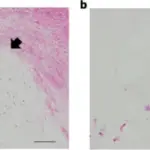Osteosarcoma is a high-grade malignant primary central sarcoma of bone characterized by the presence of an osteoid extracellular matrix.
What is the Pathology of Osteosarcoma?
The pathology of osteosarcoma is:
-Etiology: The cause of osteosarcoma is unknown.
-Genes involved: TP53, RB1.
-Pathogenesis: The sequence of events that lead to osteosarcoma occurs when a healthy bone cell develops changes in its DNA.
-Histology: The histology associated with osteosarcoma shows sarcomatous tumor cells that produce malignant bone or osteoid.
How does Osteosarcoma Present?
Patients with osteosarcoma typically affect males more than females in childhood and adulthood. The symptoms, features, and clinical findings associated with osteosarcoma include pain that may be worse at night, maybe intermittent and of varying intensity, and may have been occurring for a long time.
How is Osteosarcoma Diagnosed?
Osteosarcoma is diagnosed by MRI, CT scan, and PET scan.
How is Osteosarcoma Treated?
Osteosarcoma is treated by a combination of chemotherapy and surgery.
What is the Prognosis of Osteosarcoma?
The prognosis of osteosarcoma is variable depending upon the stage of the tumor. Stage 1 has an excellent prognosis. Stage 2 has a poor prognosis.



